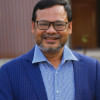State of nuclear safety education and research in Bangladesh
After the independence of Bangladesh in 1971, the Father of the Nation Bangabandhu Sheikh Mujibur Rahman established Bangladesh Atomic Energy Commission (BAEC) by President's Order No. 15 of 1973 for the purpose of strengthening the peaceful use of atomic energy and establishing the Rooppur nuclear power plant. The primary work of the atomic energy commission was to establish larger research institutes like Pakistan Institute of Nuclear Science and Technology (PINSTECH) or UK's Atomic Energy Research Establishment (AERE) for the purpose of making breakthroughs by undertaking research and development work in different areas of nuclear science and technology. Then by the explicit involvement of the most prominent nuclear scientist Dr MA Wazed Miah, Bangabandhu Sheikh Mujibur Rahman sanctioned the BAEC 265-acre land at Ganakbari, Savar. As a result, BAEC's largest research institute, the Atomic Energy Research Establishment (AERE), was established in 1975. In this establishment, a 3 MWth TRIGA Mark-II research reactor was installed and commissioned in 1986.
From 1973 to date, despite noteworthy contributions by nuclear scientists, engineers and doctors in health, industry, agriculture, environment and human resource development areas, it was not possible to achieve the expected goal because of limited resources and infrastructural constraints.
Keeping in mind the need to overcome the country's fuel crisis and energy security issues and to meet the energy demands to become a middle income country by 2021 and a developed country by 2041, the government of Bangladesh with the help of Russia took up the decision of implementing the Rooppur nuclear power plant project in 2009. The construction of two units of the VVER-1200 nuclear reactor with a combined output of 2400 MWe is going on at present. It is estimated that one of the two units will go into operation by 2023 and the other by the following year. As Bangladesh is a newcomer in the nuclear power programme, national nuclear safety infrastructure must be developed in order to ensure the highest possible levels of safety throughout the entire lifetime of all nuclear facilities and activities. The prime responsibility lies with the government to establish an effective regulatory body with the necessary legal framework and other relevant national authorities in cooperation with international organisations in order to build and maintain a robust national nuclear safety infrastructure. On the other hand, ensuring safety—based on regulatory requirements and guidance set forth for the facilities and activities that give rise to radiation risks—is the responsibility of the operating organisation.
A nuclear power programme is highly infrastructure-dependent, sophisticated and technologically extensive. The success of a nuclear power programme of any country solely depends on how the safety aspects, particularly a safety culture, have been incorporated in its programme. TMI (1979), Chernobyl (1986) and Fukushima (2011) nuclear accidents occurred due to a weak safety culture. These accidents have resulted in negative growth of nuclear energy. There is much concern worldwide about the safety of nuclear technology.
With the purpose of creating knowledgeable manpower in nuclear technology and engineering and for the successful establishment and sustainable operation of a nuclear power programme, the University of Dhaka established the Nuclear Engineering Department for the first time in 2012. Academic activities began with the master's programme the same year and the honours programme the following year. In tandem with the University of Dhaka, MIST established its nuclear engineering department in 2014. In 2016, BUET founded an institute named Institute of Nuclear Power Engineering but its academic activities have not yet begun.
After getting involved in education and research activities in nuclear engineering, I noticed that there exists a lack of knowledgeable manpower in almost all areas of nuclear safety. Nuclear safety refers to the protection of people and the environment against radiation risks and the safety of facilities and activities that give rise to such risks. Nuclear safety disrupts when there are unintended conditions or events leading to radiological releases from authorised activities. It could happen in nuclear installations due to the lack of intelligent planning, proper design with conservative margins and backup systems, high-quality components and a well-developed safety culture during the management, site selection, design, construction, operation, maintenance, and decommissioning stages.
Safety has been an important consideration from the very beginning of the development of nuclear reactors when Enrico Fermi developed the first artificial nuclear reactor on December 2, 1942 where a nuclear chain reaction took place, controlled, and sustained. The term safety as used here includes the safety of nuclear facilities and the activities associated thereto. It does not cover non-radiation related safety.
With an aim of establishing a global safety regime, IAEA was created in 1957 to monitor and advocate the nuclear safety issues for countries embarking on a nuclear power programme and/or radiological activities for peaceful purposes. The first IAEA safety standard series focusing on how to handle safely the radionuclides evolved in 1958 in cooperation with a group of international experts. The IAEA safety standards consist of three pillars: safety fundamentals, safety requirements and safety guides.
Safety fundamentals establish the fundamental safety objective and principles of protection and safety and provide the basis for safety requirements. Safety requirements set out the requirements that must be met to ensure the protection of people and the environment for the present and the future. These requirements are governed by the objective and principles of the safety fundamentals. Safety guides provide recommendations and guidance on how to comply with the requirements.
The IAEA safety standard series is applicable for those countries that have nuclear facilities and activities or those going to develop a national nuclear infrastructure for the peaceful use of nuclear energy. It refers to competence, education, training, human resources, knowledge management and knowledge networks. It now has about 142 publications covering all areas of safety including management, site evaluation, design, construction, operation, maintenance regulatory control and function, nuclear and radiological waste, fuel cycles, transport and more.
In the context of safety education, research, and training activities, our academic curricula include safety analysis during design, siting, operation, safety regulation and control, nuclear accidents and safety issues. It also includes IAEA safety standards and safety culture. Since the academic programme is new, it is yet to set up thermohydraulic and fuel cycle safety laboratories. Limited safety related research is ongoing using codes and analytical methods. BAEC is doing limited safety research using codes such as RELAP, MCNP, etc. However, there is no such laboratory at BAEC or regulatory body.
For the successful and safe implementation of a nuclear power programme there should not be any scope of bureaucratic bottleneck, politics, and personal problems among each of the stakeholder organisations such as concerned ministries, regulatory bodies, operating organisations, educational institutes, and technical support organisations. All stakeholders need to work hand in hand. It is essential to develop a national strategic approach to education, research, and training in nuclear safety in line with the IAEA safety standards. It requires a high level of national commitment. Without a sustainable national nuclear safety infrastructure, it would be hard indeed to operate a nuclear power programme in a safe and sustainable manner. This is because safety comes first. It is worth mentioning that nuclear technology is ever-changing and evolving quite rapidly. The new generation of nuclear reactors is being developed with modern technology and enhanced safety features. There will be no such accidents like Chernobyl (1986) or Fukushima (2011) in the new generation of modern reactors like VVER-1200 generation III+ reactor which is selected for the Rooppur site. However, there is no other alternative except to develop a national nuclear safety infrastructure, competent human resources, and safety culture through proper policy, education, research, and training.
The writer is Chairman, Department of Nuclear Engineering, University of Dhaka. Email: [email protected]

 For all latest news, follow The Daily Star's Google News channel.
For all latest news, follow The Daily Star's Google News channel. 



Comments